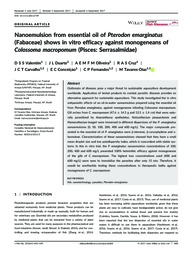Nanoemulsion from essential oil of Pterodon emarginatus (Fabaceae) shows in vitro efficacy against monogeneans of Colossoma macropomum (Pisces: Serrasalmidae).
Nanoemulsion from essential oil of Pterodon emarginatus (Fabaceae) shows in vitro efficacy against monogeneans of Colossoma macropomum (Pisces: Serrasalmidae).
Author(s): VALENTIM, D. S. S.; DUARTE, J. L.; OLIVEIRA, A. E. M. F. M.; CRUZ, R. A. S.; CARVALHO, J. C. T.; CONCEIÇÃO, E. C.; FERNANDES, C. P.; TAVARES-DIAS, M.
Summary: Outbreaks of diseases pose a major threat to sustainable aquaculture development worldwide. Application of herbal products to combat parasitic diseases provides an alternative approach for sustainable aquaculture. This study investigated the in vitro antiparasitic effects of an oil-in-water nanoemulsion prepared using the essential oil from Pterodon emarginatus, against monogeneans infesting Colossoma macropomum. Gill arches from C. macropomum (47.6 14.5 g and 13.5 1.4 cm) that were naturally parasitized by Anacanthorus spathulatus, Notozothecium janauachensis and Mymarothecium boegeri were immersed in different dispersions of the P. emarginatus nanoemulsions (0, 50, 100, 200, 400 and 600 mg/L). The major compounds presented in the essential oil of P. emarginatus were b-elemene, b-caryophyllene and ahumulene. Characterization of these nanoemulsions showed that they have a small mean droplet size and low polydispersity index, which is concordant with stable systems. In this in vitro trial, the P. emarginatus nanoemulsion concentrations of 100, 200, 400 and 600 mg/L presented 100% helminthic efficacy against monogeneans of the gills of C. macropomum. The highest two concentrations used (400 and 600 mg/L) were seen to immobilize the parasites after only 15 min. Therefore, it would be worthwhile testing these concentrations in therapeutic baths against monogeneans of C. macropomum.
Publication year: 2018
Types of publication: Journal article
Unit: Embrapa Amapá
Observation
Some of Embrapa's publications are published as ePub files. To read them, use or download one of the following free software options to your computer or mobile device. Android: Google Play Books; IOS: iBooks; Windows and Linux: Calibre.
Access other publications
Access the Agricultural Research Database (BDPA) to consult Embrapa's full library collection and records.
Visit Embrapa Bookstore to purchase books and other publications sold by Embrapa.

